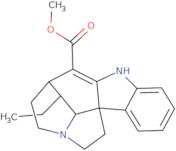
Product Information
- (+)-19,20-Dihydrocondylocarpine
- (+)-Tubotaiwine
- (20S)-19,20-Dihydrocondylocarpine
- 20(S)-Tubotaiwine
- 3,5-Ethano-3H-pyrrolo[2,3-d]carbazole-6-carboxylic acid, 4-ethyl-1,2,3a,4,5,7-hexahydro-, methyl ester, (3S,3aR,4S,5S,11bS)-
- 3,5-Ethano-3H-pyrrolo[2,3-d]carbazole-6-carboxylic acid, 4-ethyl-1,2,3a,4,5,7-hexahydro-, methyl ester, [3aR-(3aα,4β,5β,11bS*)]-
- 3,5-ethano-3H-pyrrolo[2,3-d]carbazole-6-carboxylic acid, 4-ethyl-1,2,3a,4,5,7-hexahydro-, methyl ester, (3aR,4S,5S,11bS)-
- Condyfolan-16-carboxylic acid, 2,16-didehydro-, methyl ester, (14S)-
- Methyl (14β)-2,16-didehydrocondyfolan-16-carboxylate
- Methyl (1S,11S,17R,18S)-18-ethyl-8,14-diazapentacyclo[9.5.2.0~1,9~.0~2,7~.0~14,17~]octadeca-2,4,6,9-tetraene-10-carboxylate
- See more synonyms
- NSC 306222
- Tubotaiwin
- Tubotaiwine (8CI)
Tubotaiwine is a n-oxide alkaloidal extract from the plant Tubocarpus sp. It has been used as a folk medicine for hypertension and leishmaniasis, and to treat diarrhea. The chemical reactions of tubotaiwine are not well understood, but it has been shown that tubotaiwine has a high content of fatty acids and monoterpenoid indole alkaloids. Tubotaiwine also possesses anti-inflammatory properties. Chemical analyses have revealed that tubotaiwine contains phenolic compounds (e.g., flavonoids) with antioxidant activity. Tubotaiwine can be used in low light conditions where other plants cannot grow; this may be due to its ability to convert light energy into chemical energy via photosynthesis or its ability to store solar energy in the form of starch or lipids. The chemical composition of tubotaiwine is similar to those found in plants such as Apocynaceae and Leishmania, which
Chemical properties
Technical inquiry about: 3D-GAA71169 Tubotaiwine
If you want to request a quotation or place an order, please instead add the desired products to your cart and then request a quotation or order from the cart. It is faster, cheaper, and you will be able to benefit from the available discounts and other advantages.





